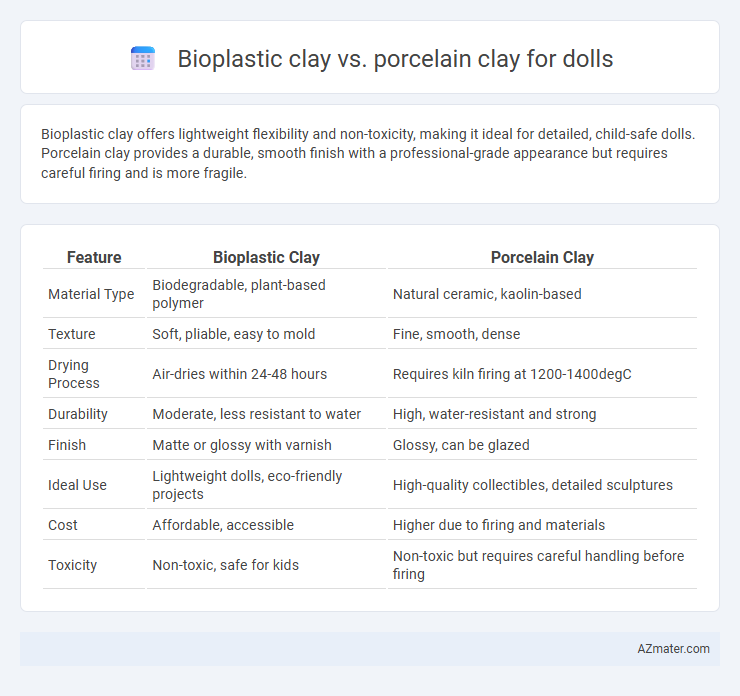Bioplastic clay offers lightweight flexibility and non-toxicity, making it ideal for detailed, child-safe dolls. Porcelain clay provides a durable, smooth finish with a professional-grade appearance but requires careful firing and is more fragile.
Table of Comparison
| Feature | Bioplastic Clay | Porcelain Clay |
|---|---|---|
| Material Type | Biodegradable, plant-based polymer | Natural ceramic, kaolin-based |
| Texture | Soft, pliable, easy to mold | Fine, smooth, dense |
| Drying Process | Air-dries within 24-48 hours | Requires kiln firing at 1200-1400degC |
| Durability | Moderate, less resistant to water | High, water-resistant and strong |
| Finish | Matte or glossy with varnish | Glossy, can be glazed |
| Ideal Use | Lightweight dolls, eco-friendly projects | High-quality collectibles, detailed sculptures |
| Cost | Affordable, accessible | Higher due to firing and materials |
| Toxicity | Non-toxic, safe for kids | Non-toxic but requires careful handling before firing |
Introduction to Bioplastic and Porcelain Clays
Bioplastic clay, a blend of polymer compounds and plasticizers, offers flexibility and lightweight properties ideal for detailed doll crafting and easy shaping. Porcelain clay, composed primarily of kaolin, feldspar, and quartz, is known for its fine texture, strength, and ability to achieve a smooth, translucent finish after firing. These clays differ significantly in durability, finish quality, and workability, influencing the choice depending on the desired doll characteristics and production method.
Material Composition and Sources
Bioplastic clay is primarily composed of natural polymers derived from renewable plant sources such as cornstarch and cellulose, making it biodegradable and environmentally friendly. Porcelain clay consists mainly of kaolin, feldspar, and quartz minerals, sourced from geological deposits, providing a dense, fine-grained structure ideal for detailed doll sculpting. The distinct material compositions influence their performance, with bioplastic clay offering flexibility and eco-conscious benefits, while porcelain clay delivers durability and a smooth, hard finish after firing.
Workability and Sculpting Ease
Bioplastic clay offers superior workability due to its pliable texture and extended drying time, making it ideal for detailed doll sculpting and fine adjustments. Porcelain clay, while less flexible and requiring precise moisture control, provides a smooth, hard finish after firing, which is favored for durability and refinement in doll crafting. Sculptors often choose bioplastic clay for initial modeling phases and porcelain clay for final, polished pieces where structural integrity is paramount.
Drying and Curing Processes
Bioplastic clay dries through air exposure, requiring several hours to fully harden without needing kiln firing, making it ideal for quick and flexible doll crafting. Porcelain clay demands a drying phase followed by high-temperature kiln firing between 1200degC to 1400degC, resulting in a vitrified, durable finish suitable for fine detailed dolls. The curing process of porcelain enhances strength and translucency, whereas bioplastic clay remains more lightweight and less fragile after drying.
Final Texture and Surface Finish
Bioplastic clay offers a softer, more flexible final texture ideal for dolls requiring slight bendability and smooth surface finishes that can be easily painted or sealed. Porcelain clay delivers a harder, more durable texture with a refined, glass-like surface finish that enhances detail and provides a polished, professional look. While bioplastic clay maintains slight elasticity after curing, porcelain clay remains rigid and brittle, making it better suited for intricate, delicate doll features.
Durability and Strength Comparison
Bioplastic clay offers superior flexibility and impact resistance, making it less prone to cracking or breaking during handling and play compared to porcelain clay. Porcelain clay provides exceptional hardness and a smooth, refined finish but is more brittle and susceptible to chipping or shattering under stress. For doll making, bioplastic clay ensures long-lasting durability and strength ideal for extensive use, while porcelain clay is preferred for display pieces requiring delicate, detailed craftsmanship.
Environmental Impact and Sustainability
Bioplastic clay is derived from renewable plant-based materials, making it a biodegradable and eco-friendly choice for doll crafting, significantly reducing landfill waste compared to conventional clays. Porcelain clay, often sourced from mined kaolin, has a higher environmental footprint due to non-renewable resource extraction and energy-intensive firing processes. Choosing bioplastic clay supports sustainability by minimizing harmful emissions and promoting the use of organic inputs throughout the production and disposal lifecycle.
Paintability and Customization
Bioplastic clay offers excellent paintability with a smooth surface that readily absorbs acrylic and water-based paints, enabling vibrant and detailed finishes ideal for doll customization. Porcelain clay, while providing a refined and durable finish, requires specialized firing and glazing techniques to achieve a polished look, making it less flexible for immediate paint application. Customization with bioplastic clay is more versatile due to its malleability and compatibility with various paints, whereas porcelain demands more skill and caution during the glazing and painting process.
Cost and Accessibility
Bioplastic clay offers a cost-effective and easily accessible alternative to porcelain clay for doll making, with prices generally lower due to its synthetic composition and widespread availability in craft stores. Porcelain clay, while more expensive and harder to source, provides superior durability and a naturally smooth finish prized by professional sculptors and collectors. The choice depends on budget constraints and the desired quality of the final doll, with bioplastic clay appealing to hobbyists and porcelain preferred for high-end, collectible dolls.
Ideal Applications for Doll Making
Bioplastic clay offers ideal applications for doll making that require flexibility and lightweight features, making it perfect for soft, bendable doll limbs and intricate details that need durability without brittleness. Porcelain clay excels in creating high-quality, collectible dolls with smooth, hard surfaces that allow for fine detailing and a polished finish, ideal for display or artistic dolls. Choosing between the two depends on whether the doll maker prioritizes durability and articulation with bioplastic or the elegant, fragile aesthetic offered by porcelain.

Infographic: Bioplastic clay vs Porcelain clay for Doll
 azmater.com
azmater.com